Learning & Development | Apprentissage et développement
> Desla44
> Organizational agility - Agilité organisationnelle
> Organizational Agility Information Watch - Veille informationnelle sur l'agilité organisationnelle
> Themes | Thèmes
Agility Creates an Upskilling Paradox. LinkedIn by Sean McPheat. Building a learning culture that drives business forward. In this episode of The McKinsey Podcast, Diane Brady speaks with Elizabeth Young McNally and Matthew Smith about how individuals and organizations can build skills and create a learning culture.
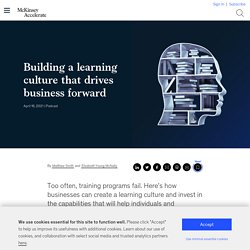
An edited transcript of their conversation follows. Diane Brady: Hello and welcome to The McKinsey Podcast.
RELATIONSHIP BETWEEN THE LEARNING ORGANIZATION AND ORGANIZATIONAL AGILITY. Charting a business course for reinforcement learning. Leaders looking for new ways artificial intelligence (AI) can provide a competitive edge may have found the 2021 America’s Cup Match as exciting for one team’s groundbreaking use of reinforcement learning as for its radical boat designs and close races.
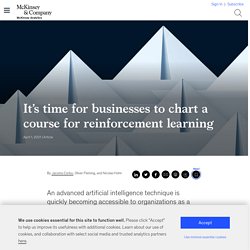
To remain competitive, sailing teams in the America’s Cup contest, like all businesses, must push the boundaries of what is possible. They also face similar constraints, including a steep development curve and a small window of opportunity, meaning teams can pursue only one or two big experiments to up their performance in the sport’s most important competition. For the 2021 edition of the America’s Cup, reigning champion Emirates Team New Zealand ventured that reinforcement learning, an advanced AI technique, could optimize its design process.
The Age of Agility: Building Learning Agile Leaders and Organizations (2 March 2021) by Veronica Schmidt Harvey and Kenneth P. De Meuse. ATD's Talent Development Capability Model - Future Readiness. The Skills Gen Y & Gen Z Struggle With. A transformation of the learning function: Why it should learn new ways. Organizations are acutely aware of the importance of learning in today’s business environment.
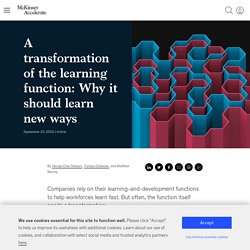
They understand that technology is changing the nature of work and the roles within it. They also understand that the ability of the workforce to learn new skills, model new behaviors, and adapt continuously is key to sustained success.
What does Agility has to do with Organizational Development & COVID-19?
The Skills Gen Y & Gen Z Struggle With. Reskilling the workforce to be resilient. A system that invests not just in workers’ near-term skill needs but also in workers’ long-term resilience can help build long-term organizational resilience in a world where the only constant is change.
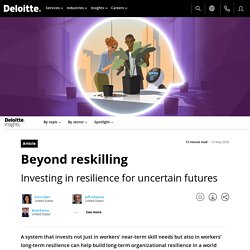
Reskilling alone may be a strategic dead end. Renewing workers’ skills is a tactical necessity, but reskilling is not a sufficient path forward by itself. The skill shortage is too great.
Report: Leadership Development In 2020. A new study reveals that leadership development has NOT adequately prepared leaders to navigate the most challenging economy in 100 years.
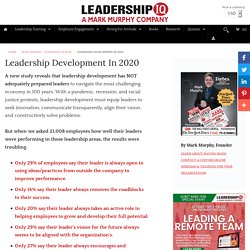
With a pandemic, recession, and racial justice protests, leadership development must equip leaders to seek innovation, communicate transparently, align their vision, and constructively solve problems. But when we asked 21,008 employees how well their leaders were performing in those leadership areas, the results were troubling. The data shows that traditional leadership development programs have left many leaders under-equipped to manage these unprecedented times.
How to rapidly build skills during crisis disruption. On the uncertain path to recovery from the coronavirus crisis, one thing is beyond doubt: a company’s ability to quickly pivot to a new way of working will be critical for preparing for the next normal.
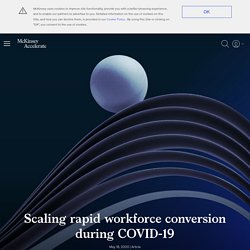
Some companies have already demonstrated that agility in a lifesaving way, such as carmakers that have shifted to building ventilators and toy makers producing hand sanitizer. These pivots will continue, compounded by the need to restart work in a dramatically changed context—and, increasingly, for workers facing new responsibilities. Consider the retail employees or security teams at once-crowded malls, who must learn how to interact with the public in safe and responsible ways, or flight attendants implementing new safety protocols.
Four different ways of knowing. The transition to a new decade often brings idealized images of the road ahead, for both companies and industries — and, of course, for the ways in which they should be led.
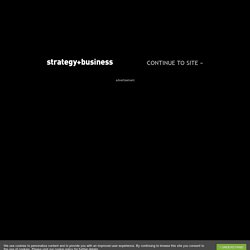
However, as we have entered a 2020 with turbulence in politics, the climate, and markets, we have been offered something equally, if not more, valuable on which to focus: The concept of how we know what we know, and how that knowledge affects the leadership decisions we make. s+b Blogs s+b Blogs. Experimentation Works: The Surprising Power of Business Experiments (2020) by Stefan H. Thomke. How to Set Up — and Learn — from Experiments. Stefan Thomke, professor at Harvard Business School, says running experiments can give companies tremendous value, but too often business leaders make decisions based on intuition.

While A/B testing on large transaction volumes is common practice at Google, Booking.com, and Netflix, Thomke says even small firms can get a competitive advantage from experiments. He explains how to introduce, run, and learn from them, as well as how to cultivate an experimental mindset at your organization. Thomke is the author of the book Experimentation Works: The Surprising Power of Business Experiments and the forthcoming HBR article “Building a Culture of Experimentation.” Download this podcast. The Irony of an Infinite Mindset. An example of mindfulness. The role of the leader and continuous learning in the reskilling era. Continuous learning in the workplace must become the new norm if individuals and organizations want to stay ahead.
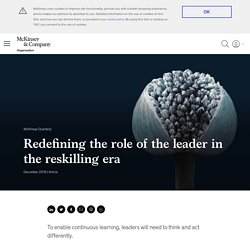
This places more demand than ever on leaders to take on a new role they might initially find unfamiliar—that of learning facilitator-in-chief. Podcast. Insight-driven organization. More than a decade after the concept of big data became part of the lexicon, only a minority of companies have become insight-driven organizations—and culture may be the culprit.
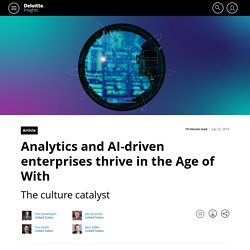
The amount of data available to organizations every day continues to proliferate at a staggering volume. But technologies such as analytics and artificial intelligence (AI) have the potential to help businesses make better use of these massive volumes of data.
Are You Increasing Your Learning Agility — Or Are You Missing Out?
How do we learn to work with intelligent machines?
Improving training to promote lifelong employability. As AI-enabled automation advances, organizations should embrace “lifelong employability,” which stretches traditional notions of learning and development and can inspire workers to adapt, more routinely, to the evolving economy. As robots and algorithms continue to become more central to the workplace, workers and employers face the enormous task of figuring out how to cope. No longer is automation a thing of the future: the McKinsey Global Institute (MGI) estimates that half of today’s work activities coordinated by humans could be automated with present-day technology.
The prosperity of high-growth. Why do some emerging economies grow rapidly while others languish? New research highlights the role of public policy, effective government, and globally competitive companies. In this episode of the McKinsey Podcast, Simon London speaks with McKinsey Global Institute (MGI) director Jonathan Woetzel and MGI partner Anu Madgavkar about their recent research on emerging economies that outperform others based on pro-growth agendas and successful companies that help propel them.
Podcast transcript. Defining Next Practice For The Intelligent Enterprise. We are facing some very big changes in the workplace, driven by technology – primarily software and data. This means that software will do repetitive tasks, make decisions, and set priorities in a wide range of areas, in all industries, and in the majority of jobs. We will have to work with and understand many different types of software robots. These changes must be driven, understood, and developed, and thus require more than traditional professionalism. The vast majority of organizations are not yet ready for these innovations. Embedded intelligence.
Are You Increasing Your Learning Agility — Or Are You Missing Out?
Which Public Agile Training Is Right For Me? (a.k.a Navigating The Agile Training Landscape) - AgileSparks. Navigating the Agile Training Landscape It’s become pretty confusing these days. If you’re interested in advancing your Agile knowledge there are so many options.
Competing on the Rate Learning. Embed autonomous learning structures throughout the enterprise. Self-executing decision loops are widely implemented in digital marketplaces. But they can be just as powerful when embedded in the administrative systems—like planning, information systems, and resource management—of the enterprise itself. This involves reconceptualizing business as an intelligent, adaptive machine, one that embodies the same algorithmic principles as purely digital systems do. Organizational structures should be decentralized, with smaller units given autonomy to act, experiment, and learn.
Insights should flow up and across the organization, rather than just downward from executives, to accelerate learning.
7-shapes School. A Practical Plan to Become a More Agile Learner. Does organisational learning help to develop organisational agility and intelligence?
These are the 5 “super skills” you need for jobs of the future. Skill shift: Automation and the future of the workforce. These are the 3 key skill sets workers will need to learn by 2030. Become a More Productive Learner.










